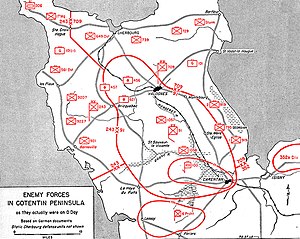Mission Chicago was a pre-dawn glider-borne combat assault in the American airborne landings in Normandy, made by elements of the 101st Airborne Division on the early morning of June 6, 1944 during the Normandy landings of World War II. It was part of Operation Neptune, the assault portion of the Allied invasion of Normandy, codenamed Operation Overlord. Originally slated to be the main assault for the 101st Airborne Division, the glider operation instead became the first reinforcement mission after the main parachute combat assault, Mission Albany. Because the area of responsibility for the division was in close proximity to Utah Beach, the use of glider reinforcement was limited in scale, with most division support units transported by sea.

The Normandy landings were the landing operations and associated airborne operations on Tuesday, 6 June 1944 of the Allied invasion of Normandy in Operation Overlord during World War II. Codenamed Operation Neptune and often referred to as D-Day, it is the largest seaborne invasion in history. The operation began the liberation of France, and the rest of Western Europe, and laid the foundations of the Allied victory on the Western Front.

The Cotentin Peninsula, also known as the Cherbourg Peninsula, is a peninsula in Normandy that forms part of the northwest coast of France. It extends north-westward into the English Channel, towards Great Britain. To its west lie the Gulf of Saint-Malo and the Channel Islands, and to the southwest lies the peninsula of Brittany.
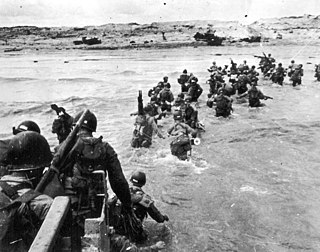
Utah, commonly known as Utah Beach, was the code name for one of the five sectors of the Allied invasion of German-occupied France in the Normandy landings on June 6, 1944 (D-Day), during World War II. The westernmost of the five code-named landing beaches in Normandy, Utah is on the Cotentin Peninsula, west of the mouths of the Douve and Vire rivers. Amphibious landings at Utah were undertaken by United States Army troops, with sea transport, mine sweeping, and a naval bombardment force provided by the United States Navy and Coast Guard as well as elements from the British, Dutch and other Allied navies.

James Maurice Gavin, sometimes called "Jumpin' Jim" and "the jumping general", was a senior United States Army officer, with the rank of lieutenant general, who was the third Commanding General (CG) of the 82nd Airborne Division during World War II. During the war, he was often referred to as "The Jumping General" because of his practice of taking part in combat jumps with the paratroopers under his command; he was the only American general officer to make four combat jumps in the war.

Sainte-Mère-Église is a commune in the northwestern French department of Manche, in Normandy. On 1 January 2016, the former communes of Beuzeville-au-Plain, Chef-du-Pont, Écoquenéauville and Foucarville were merged into Sainte-Mère-Église. On 1 January 2019, the former communes of Carquebut and Ravenoville were merged into Sainte-Mère-Église.

Carentan is a small rural town near the north-eastern base of the French Cotentin Peninsula in Normandy in north-western France, with a population of about 6,000. It is a former commune in the Manche department. On 1 January 2016, it was merged into the new commune of Carentan-les-Marais. The town was a strategic early goal of the World War II landings as capturing the town was necessary to link the lodgements at Utah and Omaha beaches which were divided by the Douve river estuary. The town was also needed as an intermediate staging position for the capture of the cities of Cherbourg and Octeville, with the critically important port facilities in Cherbourg.

The 709th Static Infantry Division was a German Army infantry division in World War II. It was raised in May 1941 and used for occupation duties during the German occupation of France in World War II until the Allied invasion. It was on the Normandy coast when the invasion occurred and so fought in the Battle of Normandy. The division was trapped in the Cotentin Peninsula and destroyed in the defense of Cherbourg.
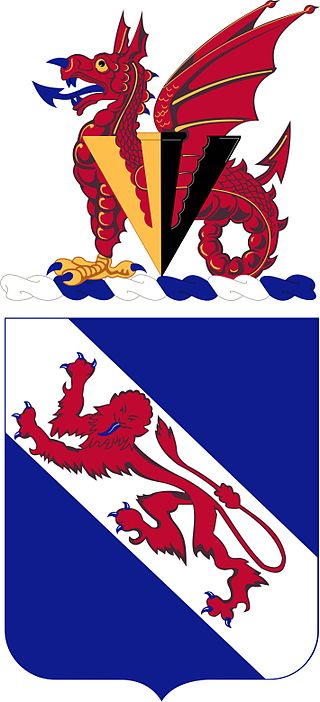
The 508th Infantry Regiment is an airborne infantry regiment of the United States Army, first formed in October 1942 during World War II. The 508th is a parent regiment under the U.S. Army Regimental System, and two battalions from the regiment are currently active: the 1st Battalion, 508th Parachute Infantry Regiment is assigned to the 3rd Brigade Combat Team, 82nd Airborne Division, and the 2nd Battalion, 508th Parachute Infantry Regiment is assigned to the 2nd Brigade Combat Team, 82nd Airborne Division. The regiment served in combat during World War II, and regimental elements have served in combat in the Dominican Republic, Vietnam, Grenada, Panama, Iraq and Afghanistan.
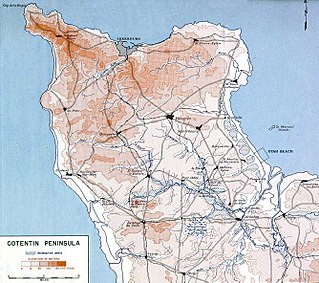
The Battle of Cherbourg was part of the Battle of Normandy during World War II. It was fought immediately after the successful Allied landings on 6 June 1944. Allied troops, mainly American, isolated and captured the fortified port, which was considered vital to the campaign in Western Europe, in a hard-fought, month-long campaign.

Sainte-Marie-du-Mont is a commune in the Manche department and in the region of Normandy in north-western France. The commune has 712 inhabitants (2019).
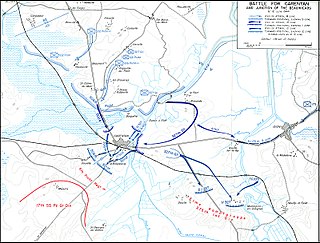
The Battle of Carentan was an engagement in World War II between airborne forces of the United States Army and the German Wehrmacht during the Battle of Normandy. The battle took place between 6 and 13 June 1944, on the approaches to and within the town of Carentan, France.

Operation Overlord was the codename for the Battle of Normandy, the Allied operation that launched the successful liberation of German-occupied Western Europe during World War II. The operation was launched on 6 June 1944 (D-Day) with the Normandy landings. A 1,200-plane airborne assault preceded an amphibious assault involving more than 5,000 vessels. Nearly 160,000 troops crossed the English Channel on 6 June, and more than two million Allied troops were in France by the end of August.

The Douve or Ouve is a river, 78.6 km (48.8 mi) in length, which rises in the commune of Tollevast, near Cherbourg in the department of Manche. Ouve is considered its old name : Ouve appears to have been misspelled over the course of time as "Douve river" and then as "River of the Douve". The French name for this watercourse is la Douve.

American airborne landings in Normandy were a series of military operations carried by the United States as part of Operation Overlord, the invasion of Normandy by the Allies on June 6, 1944 during World War II. Approximately 13,100 American paratroopers from the 82nd and 101st Airborne Divisions conducted parachute drops, followed by 3,937 glider infantrymen, on June 6. As the opening maneuver of the Normandy landings, the two American airborne divisions were dropped in Normandy via two parachute and six glider missions.

Charles Neilans DeGlopper was a soldier of the United States Army who posthumously received the Medal of Honor, the highest award of the U.S. military, for his heroic actions and sacrifice of life during the early stages of the Battle of Normandy in World War II.

Mission Albany was a parachute combat assault at night by the U.S. 101st Airborne Division on June 6, 1944, part of the American airborne landings in Normandy during World War II. It was the opening step of Operation Neptune, the assault portion of the Allied invasion of Normandy, Operation Overlord. Five hours ahead of the D-Day landings, 6,928 paratroopers jumped from 443 C-47 Skytrain troop-carrier planes into the southeast corner of France's Cotentin Peninsula. The troops were meant to land in an area of roughly 15 square miles (39 km2), but were scattered by bad weather and German ground fire over an area twice as large, with four sticks dropped as far as 20 miles (32 km) away.
Mission Boston was a parachute combat assault at night by Major General Matthew Ridgway's U.S. 82nd Airborne Division on June 6, 1944, part of the American airborne landings in Normandy during World War II. Boston was a component element of Operation Neptune, the assault portion of the Allied invasion of Normandy, codenamed Operation Overlord. 6,420 paratroopers jumped from nearly 370 C-47 Skytrain troop carrier aircraft into an intended objective area of roughly 10 square miles (26 km2) located on either side of the Merderet river on the Cotentin Peninsula of France, five hours ahead of the D-Day landings.

The 84th Fighter Wing is an inactive United States Air Force unit. Its last assignment was with the IX Tactical Air Command, based at Brunswick, Germany. It was inactivated on 12 August 1945.

The Battle of Saint-Malo was fought between Allied and German forces to control the French coastal town of Saint-Malo during World War II. The battle formed part of the Allied breakout across France and took place between 4 August and 2 September 1944. United States Army units, with the support of Free French and British forces, successfully assaulted the town and defeated its German defenders. The German garrison on a nearby island continued to resist until 2 September.

